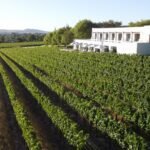Aging wine in oak barrels is a time-honored practice that significantly influences a wine’s flavor, aroma, and texture. This method has been utilized by winemakers for centuries, and understanding the essentials of this process can enhance both your appreciation for wine and your knowledge of winemaking. Here’s a comprehensive overview of the essentials of wine aging in oak barrels.
- The Types of Oak
The selection of oak type is crucial in influencing the characteristics of the wine:
– French Oak: Known for its fine grain, French oak imparts subtle flavors, such as vanilla, spice, and toast, making it ideal for delicate wines like Chardonnay and Pinot Noir. Its tighter grain allows for slower oxygen exchange, enhancing complexity.
– American Oak: Characterized by its more pronounced vanilla and coconut flavors, American oak is often used for bolder wines, such as Cabernet Sauvignon and Zinfandel. Its wider grain allows for quicker oxidation, contributing to a more robust flavor profile.
– Hungarian Oak: This oak type combines characteristics of both French and American oak, offering spice and subtle sweetness. It’s becoming more popular among winemakers for its versatility.
- Barrel Characteristics
Different barrel characteristics can impact how the wine ages:
– Barrel Size: Standard Bordeaux barrels, known as barriques, hold about 225 liters (59 gallons). Larger barrels (like the 500-liter tonneau) impart less oak flavor due to the ratio of wine surface area to oak. Smaller barrels can lead to more intense flavor profiles.
– Toasting Levels: The degree of toasting applied to the barrel can also affect the final wine. Lightly toasted barrels impart more subtle nuances, while heavily toasted barrels can add richer, stronger flavors, such as caramel and smoke.
- The Aging Process
Aging in oak barrels is a complex process involving several factors, including oxygen interaction and evaporation:
– Oxygenation: Oak is porous, allowing small amounts of oxygen to enter the barrel. This slow oxidation softens tannins and promotes the development of flavors and aromas. It can also help to stabilize color and enhance complexity in the wine.
– Evaporation: As wine ages in barrels, some liquid is lost due to evaporation—this is referred to as the “angel’s share.” This loss can concentrate the flavors of the remaining wine, leading to a richer, more complex profile.
– Integration: Over time, components of the wine, such as tannins, acids, and sugars, integrate and harmonize, contributing to a smoother mouthfeel and a more balanced flavor.
- Duration of Aging
The duration of aging can vary widely depending on the style of wine and the desired outcome:
– White Wines: Many white wines, particularly those made from Chardonnay, benefit from 6 to 12 months of aging in oak to develop complexity without overpowering the fruit flavors.
– Red Wines: Red wines can be aged longer, often ranging from 12 months to several years. Bold varietals like Cabernet Sauvignon often thrive with extended oak aging, allowing for deeper integration and maturation of flavors.
- Monitoring and Tasting
Winemakers regularly monitor wine during the aging process:
– Tasting Samples: Winemakers taste the wine periodically to assess its development and determine the ideal bottling time. This allows them to balance flavors and decide when the wine has achieved its desired profile.
– Winemaking Decisions: Depending on the taste testing results, winemakers may choose to blend different barrels, adjust the aging time, or even switch barrels midway to achieve specific flavor profiles.
- Impact on Final Wine
The influence of oak barrel aging on the final wine can be profound:
– Flavor Profile: Oak aging adds complexity and depth to wines. Expect flavors of vanilla, baking spices, butter, or smoke, depending on the type of oak and duration of aging.
– Mouthfeel and Structure: Tannins from oak can contribute to a smoother mouthfeel and add structure, making the wine more age-worthy.
– Aroma Enhancement: The aromatic complexity of aged wines often includes notes of spice, herbs, and nuances derived from the oak, significantly enhancing the overall experience.
- Sustainability and Innovation
Increasingly, winemakers are considering sustainability in their choice of oak barrels:
– Sourcing Responsibly: Many producers prioritize sustainably sourced oak and look for barrels from cooperages with environmentally friendly practices.
– Alternative Aging Techniques: Some wineries are experimenting with alternatives to traditional oak barrels, such as oak chips or staves, to impart character to the wine while minimizing resource use.
Conclusion
Aging wine in oak barrels is an essential component of the winemaking process that greatly enriches the final product. By understanding the types of oak, barrel characteristics, aging processes, and the overall impact on wine, you can enhance your appreciation for the complexities involved. Whether you’re a casual wine drinker or an aspiring winemaker, recognizing the role of oak aging opens a new dimension in the world of wine. So, the next time you savor a beautifully aged wine, take a moment to appreciate the journey it has taken from grape to glass!










